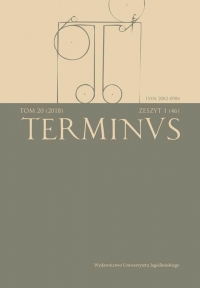„Poeta laureatus” Stefan Jaworski i emblematyka
Poeta laureatus Stefan Jaworski and Emblematics
Author(s): Walter KrollSubject(s): Cultural history, Studies of Literature, Social history
Published by: Wydawnictwo Uniwersytetu Jagiellońskiego
Keywords: rhetoric; emblematic practice; intermediality and intertextuality; combination of heraladic and emblematic signs (projection; transfiguration); elegy of library
Summary/Abstract: The aim of the paper is to present and analyze emblematic icons in the Polish-language works of Stefan Jaworski (1658—1722) with regard to the reception of rhetoric and emblematics in the Kiev-Mohyla Academy milieu. The considerations are divided into four parts. 1. Biography and studies. Jaworski received his education first in the trilingual Kiev-Mohyla Collegium (where he became familiar with the rhetorical system of writing verse), and then at universities in Lublin, Poznań and Vilnius. His learning was based on the Jesuit school model of Ratio studiorum. In these schools, Jaworski perfected his proficiency in Polish and Latin, broadening his knowledge in rhetoric, poetics, philosophy, theology, homiletics and emblematics. 2. The analysis of emblematic works and practices. In the years 1684—1691, four panegyric works were created by Jaworski. The first one (Hercules post Atlantem infracto virtutum robore honorarium pondus sustinens…, Czernihów c. 1684) contains no emblems and is only briefly described in the paper. Emblems and coats of arms appear in Jaworski’s subsequent panegyrics: Echo głosu wołającego na puszczy od serdecznej refleksyi pochodzące a przy solennym powinszowaniu … Janowi Mazepie hetmanowi wojsk… (The Echo of a Voice of One Calling in the Wilderness, Coming From Heartfelt Refl ection and Accompanied by Solemn Felicitation … to Ivan Mazepa…, Hetman), Kiev 1689; Arctos et antarctos caeli Rossiaci in gentilibus syderibus…, Kiev 1690; Pełnia nieubywającej chwały w herbowym księżycu z trzech primae magnitudinis luminarzow, Barłaama świętego pustelnika, Barłaama świętego męczennika, Barłaama świętego pieczarskiego… (The Plenitude of Inexhaustible Glory in the Heraldic Moon From Three Luminaries Primae Magnitudinis, Barlaam the Saint Hermit, Barlaam the Saint Martyr, Barlaam the Saint of Pechersk), Kiev 1691. In 2018, these works were made available by the website http://polishemblems.uw.edu.pl/index.php/pl/news/69-stefan-jaworski-i-emblematyka. In Jaworski’s panegyrics, two innovative models of emblematic practice can be distinguished: (a) creating new emblems through the projection of iconographic signs from the Mazepa coat of arms onto emblems from Saavedra’s collection in Echo głosu…, and through the transfiguration of Jasiński’s coat of arms in Arctos et antarctos…; (b) the construction of emblematic combinations out of motifs from Western European emblem books (Pietrosancta) in the panegyric Pełnia nieubywającej chwały… 3. Emblematic practice versus the theory of the emblem. This part is devoted to the question of how Jaworski’s emblematic practice can be understood in relation to late-Baroque emblematic theory. Although terms such as emblema, hieroglyphicum and symbolum can be found in Jaworski’s rhetoric Риторическая рука, they lack appropriate definition. They are named interchangeably in the part of inventio, and used as visual tropes in speech or verse writing as well as devices of the art of memory (ars memorativa). After an analysis of his emblematic practice, one can conclude that Jaworski—like Pontanus—preferred a tripartite construction of his pictorial-verbal combinations (emblema triplex: inscriptio, pictura, subscriptio). However, he would introduce not one but several inscriptions to his emblems (see Echo głosu…) and extend the subscription to epic proportions in all of his panegyrics. An overview of the definition of the emblem in Ukrainian rhetoric books confirms that Jaworski relied on a definition by the Jesuit Jacob Masen (Speculum imaginum veritatis occultae), for whom emblema, symbolum, hieroglyphicum et aenigma were subordinate to the term imagines figuratae. 4. Concluding remarks. Jaworski’s last two (Latin) texts: the elegy of the library, and the epigram in his last will (1721) can be treated as a summary of his emblematic thought and his explanation of intradiegetic signs.
Journal: TERMINUS
- Issue Year: 20/2018
- Issue No: 2 (47)
- Page Range: 195-253
- Page Count: 59
- Language: Polish

